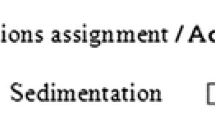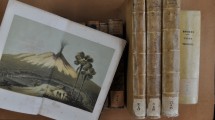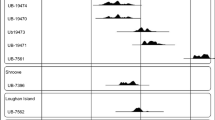Abstract
In their Manual for the Arrangement and Description of Archives, Muller, Feith, and Fruin compared the accumulation of archival materials with the geological process of deposit of sedimentary materials. This metaphor remained embedded in the European archival traditions and has continued to be discussed until the present, for instance, in the Italian archival literature. This paper explores, from a historical perspective, how and why this metaphor was adopted during the foundational period of modern archival science. The paper analyzes the links between geology and archival science as enterprises involved with historical reconstruction. The paper argues that as palaetiological disciplines, both shared a concern with issues of evidence in the study of individual, historically formed entities. Viewing the formation of archives as parallel to the deposition of sediments provided archival scholars at the turn of the twentieth century with a way of conceptualizing archival thinking as positive scientific knowledge of an essentially individual entity: the archives. This metaphor aligned archival science along with other historical sciences that could boast a measure of reputation and success. The metaphor also matched perfectly the modernist regime of historicity characteristic of the foundational period and culture of the modern archival discipline.
Similar content being viewed by others
Notes
The distinction refers to two ends of the spectrum of the possibilities of accumulation of records. The archivethesaurus is an accumulation of selected records, traditionally charters, treaties, and other such important documents that provided evidence of privileges and rights; the archive-sediment refers to the continuous and spontaneous accumulation of records from daily activities. Historically, the move from archive-thesaurus to archive-sediment reflects the transition in institutional structures from the late medieval to the modern period. See Caravaca 2015.
References
Bautier R-H (1961) Les archives. In: Samaran C (ed) L’histoire et ses méthodes. Encyclopédie de la Pléiade, v. 11. Galimard, Paris, pp 1120–1167
Bologna M (2017) Historical sedimentation of archival materials: reinterpreting a foundational concept in the Italian archival tradition. Archivaria 83:35–57
Brothman B (2006) Archives, life cycles, and death wishes: a helical model of record formation. Archivaria 61:235–269
Burke P (2003) Images as evidence in seventeenth-century Europe. J Hist Ideas 64:273–296
Burtin F-X (1784) Oryctographie de Bruxelles. Impr. De la Marie, Bruxelles
Cuvier G (1997) Extract from a memoir on an animal of which the bones are found in the plaster stone around Paris, and which appears no longer to exist alive today. [Originally published in 1812] In: Rudwick MJS (ed) Georges Cuvier, fossil bones, and geological catastrophes: new translations and interpretations of the primary texts. University of Chicago Press, Chicago
Eknoyan G (2007) Looking at the urine: the renaissance of an unbroken tradition. Am J Kidney Dis 49:865–872
Gere C (2002) Inscribing nature: archaeological metaphors and the formation of new sciences. Pub Archaeol 2:195–208
Ginzburg C (1980) Morelli, Freud and Sherlock Holmes: clues and scientific method. Hist Workshop 9:5–36
Hartog F (2015) Regimes of historicity: presentism and experiences of time. Columbia University Press, New York (Translated by Saskia Brown)
Hooke R (1705) Lectures and discourse of earthquakes, and subterraneous eruptions. In: The posthumous works of Dr. Robert Hooke. Smith & Walford, London, pp 279–450
Horsman P, Ketelaar E, Thomassen T (2003) New respect for the old order: the context of the Dutch manual. Am Arch 66:249–270
Hsu K-T (2009) The path to Steno’s synthesis on the animal origin of glossopetrae. In: Rosenberg GD (ed) The revolution in geology from the renaissance to the enlightenment, vol 203. Geological Society of America Memoir, Boulder, pp 93–106
Huxley TH (1896) On the method of the Zadig. In: Science and Hebrew tradition: essays. Appleton, New York, pp 1–23
Ilerbaig J (2016) Organisms, skeletons, and the archivist as paleontologist: metaphors of archival order and reconstruction in context. In: Foscarini F, MacNeil H, Mak B, Oliver G (eds) Engaging with records and archives: histories and theories. Facet, London, pp 21–40
Jenkinson H (1937) A manual of archive administration, 2nd edn. Percy Lund, Humphries & Co, London
Kaplan E (1963) Robert Recorde and the authorities of uroscopy. Bull Hist Med 37:65–71
Lodolini E (1985) Archivistica: principi e problemi [Archival science: principles and problems], 2nd edn. Franco Angelli, Milan
Mata Caravaca M (2015) The concept of archival ‘sedimentation’: its meaning and use in the Italian context. Arch Sci. https://doi.org/10.1007/s10502-015-9256-2
Momigliano A (1950) Ancient history and the antiquarian. J Warburg Courtauld Inst 13:285–315
Muller S, Feith KJ, Fruin R (1940) Manual for the arrangement and description of archives. H.W. Wilson, New York (Translation of Handleiding voor het ordenen en beschrijven van archieven, 2nd ed., 1920, by AH Leavitt)
Oldroyd D (1979) Historicism and the rise of historical geology. Hist Sci 17(191–213):227–257
Procter M (2008) Life before Jenkinson: the development of British archival theory and thought at the turn of the twentieth century. Archives 33:136–157
Rappaport R (1982) Borrowed words: problems of vocabulary in eighteenth-century geology. Br J Hist Sci 15:27–44
Rappaport R (1997) When geologists were historians, 1665-1750. Cornell University Press, Ithaca
Rudwick MJS (2005) Bursting the limits of time: the reconstruction of geohistory in the age of revolution. University of Chicago Press, Chicago
Steno N (1669) De solido intra solidum naturaliter contento dissertationis prodromus. Florence (English translation: The prodromus of Nicolaus Steno’s dissertation concerning a solid body enclosed by process of nature within a solid). Macmillan, London, 1916
Whewell W (1847) Philosophy of the inductive sciences. John Parker, London
Woodall J (1617) The surgions mate, or military and domestique surgery. London
Acknowledgements
The author thanks Fiorella Foscarini for her comments on this paper.
Author information
Authors and Affiliations
Corresponding author
Additional information
Publisher's Note
Springer Nature remains neutral with regard to jurisdictional claims in published maps and institutional affiliations.
Rights and permissions
About this article
Cite this article
Ilerbaig, J. Archives as sediments: metaphors of deposition and archival thinking. Arch Sci 21, 83–95 (2021). https://doi.org/10.1007/s10502-020-09350-z
Published:
Issue Date:
DOI: https://doi.org/10.1007/s10502-020-09350-z




